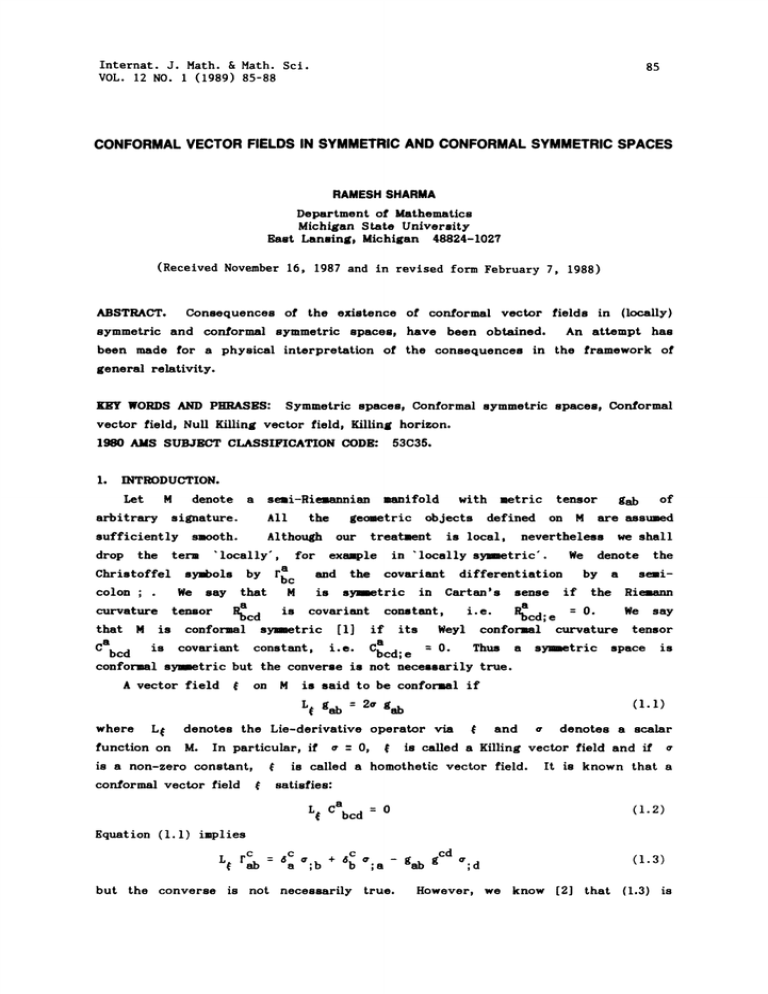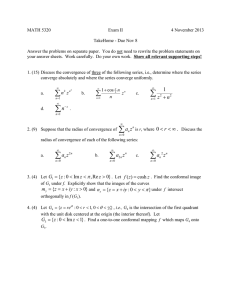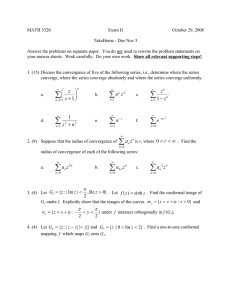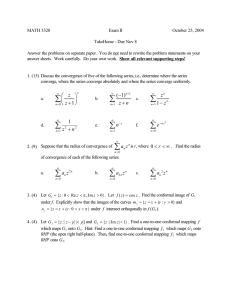Document 10438022
advertisement

Internat. J. Math. & Math. Scl.
VOL. 12 NO.
(1989) 85-88
85
CONFORMAL VECTOR FIELDS IN SYMMETRIC AND CONFORMAL SYMMETRIC SPACES
RAMESH SHARMA
Department of Mathematics
Michigan State University
East Lansing, Michigan 48824-1027
(Received November 16, 1987 and in revised form February 7, 1988)
Consequences of the existence of conformal vector fields in (locally)
An attempt has
ABSTRACT.
symmetric and conformal symmetric spaces, have been obtained.
been made for a physical interpretation of the consequences in the framework of
general relativity.
KEY WORDS AND PHRASES: Symmetric spaces, Conformal symmetric spaces, Conformal
vector field, Null Killing vector field, Killing horizon.
1980 AMS SUBJECT CLASSIFICATION CODE: 53C35.
I.
INTRODUCTION.
Let M denote
of
semi-Riemannian manifold
with metric tensor
gab
geometric objects defined on M are assumed
the
All
sufficiently smooth.
Although our treatment is local, nevertheless we shall
drop the term "locally’, for example in "locally symmetric’.
We denote the
a
semiby a
Christoffel symbols by r
the covariant differentiation
and
bc
We say that
colon
M is symmetric in Caftan’ s sense if the Riemann
a
a
We say
curvature tensor
i.e.
is covariant constant,
O.
d
e
Weyl conforsml curvature tensor
that M is conformal sysmetric [1] if its
a
Ca
is covariant constant, i.e. C
O.
Thus a symmetric space is
bcd
bcd;e
conformal symmetric but the converse is not necessarily true.
A vector field
on M is said to be conformal if
(I.I)
gab 2 gab
arbitrary
a
signature.
Rc
Rcd;
L
where
-
denotes the Lie-derivative operator via
and
denotes a scalar
function on M. In particular, if
is called a Killing vector field and if
0,
is a non-zero constant,
is called a homothetic vector field. It is known that a
conformal vector field
satisfies:
L(
a
L C bcd
Equat ion
1.1
i. 2)
0
implies
Lt
c
tab
ca
;b
+
c
#b
;a
but the converse is not necessarily true.
gab
gCd ;d
(1.3)
However, we know [2] that {1.3) is
86
R. SHARI
equivalent to
L gab
hab
where
is
a
gab +
2
constant
covariant
hab
tensor
(1.4)
A
field.
vector
field
is said to be affine conformal [2] and is said to
group of conformal collineations [3,4].
An affine
conformal vector field with constant
0)
(i. e.
is known as an
r
affine Killing vector field (which preserves the geodesics). For (i) a compact
orientable positive definite Riemannian manifold without boundary, {ii) an irreducible
positive definite Riemannian manifold and (iii) an
n(n Y 2)
dimensional non-flat
space-form; an affine conformal vector field reduces to conformal vector field. For a
(1.3)
satisfying
generate
a
or
(1.4)
one-parameter
L abc
non-Einstein conformally flat space of dimension Y 2;
that
hab
is a linear combination of
Levine and Katzin [5] proved
and the Ricci tensor
gab
Rab.
Conformal motion (generated by a conformal vector field) is a natural symmetry
of
the
by
manifolds
general
space-time
inherited
its
relativity,
in
causality-preserving [6] character.
But sometimes, it is desirable to consider
It was
conformal motions which provide covariant conservation law generators.
pointed out by Katzin et al [7] that there is a fundamental symmetry called
curvature collineation (CC) defined by a vector field
satisfying
a
L R bcd
I. 5)
0
Komar’s identities [8] (which define
a conservation law generator) follow naturally by
A conformal vector which also generate CC, is called a
special conformal vector. A conformal vector is special conformal vector iff
0
(l.S)
the existence of
CC.
The purpose of this paper is to study the consequences of the existence of (i) a
special conformal vector field in a symmetric space and (ii) a conformal vector field
in a conformal symmetric space; and indicate the physical interpretation of the
consequences within the framework of general relativity.
SYMMETRIC AND CONFORMAL SYMMETRIC SPACES.
Here we prove two theorems as follows:
THEOREM I. Let a non-flat symmetric space M of dimension n
4, admit a
special conformal vector field
Then either (i) M has zero scalar curvature and
grad
reduces to a homothetic vector field.
is a null F’llinE vector field, or (ii)
(Note that the above theorem is valid also for an affine conformal vector field,
in which case the alternative conclusion (ii) would be:
reduces to an affine
Killing vector field. The proof is common).
PROOF. We have the following identity [9]:
b
b
f
f
raf)R cde
rac) R fde
2.
.
L(Rbcde;a
(L(
Rbcde);a
(L@
(L
f b
(Lr ad )R cfe (L
f
b
rae R cdf
By our hypothesis the left hand side vanishes and consequently, in view of (1.3) the
above equation assumes the form:
CONFORMAL VECTOR FIELDS IN SYMMETRIC AND CONFORMAL SYMMETRIC SPACES
ba f Rfcde +
+ r
a
gad
where
a
cde
gac
Rbcfe rf
stands for
b
Rb cde
a
+
;a.
Rb fde
M
rf +
Rbcda
e
+
Rb ade
ub
O’d__
car
Rbcde
a
b
+
(2.1)
R cde
a
gas
f
b
R
cdf
,a)Rbcde
ca
yields
0
is not flat and therefore the above equation shows
(
0
G
which implies that either (i) grad
is constant.
c
Taking the product of both sides with
(Ca
As per our hypothesis,
Racde
87
is null (a non-zero vector of zero norm), or (ii)
We first take up case (i).
(n
f
4)f a e
Successive contractions of (2.1) lead to
R
(2 2)
e
Two subcases arise: If n = 4, then (2.2) gives R = 0. If n > 4, then using the
condition (1.6) obtains Rfe f = 0. This, substituted in (2.2), shows that R = 0.
Thus, in case (i) grad
is null and Killing (in virtue of (1.6)) and the scalar
curvature R vanishes identically. In case (ii) t is homothetic or affine Killing
according as t is conformal or affine conformal. This proves the theorem.
THEOREM 2. Let a conformal symmetric space M (dim M > 3) admit a conformal
vector field
Then one of the following holds:.
M is conformally flat
(i)
grad
is a null vector
(ii)
(iii) t reduces to a homothetic vector field.
were non-homothetic special conforms/ vector field and M were
In particular, if
not conformally flat, then grad
would have been null and Killing to
PROOF. Consider the identity [9]:
.
Lt(Cbcde; a) -(Lt Cbcde);a
(L
(L
f
rad)Cbcf
e
t
b
-(L
raf)Cfcd
e
t
(L
f
f
rac) C
b
fde
b
r )c
t ae cdf
Observe that the left hand side vanishes because
M is conformal symmetric and
(1.2) holds for a conformal vector field. By use of (1.3) in the above equation and
contracting at a and b we obtain (noting dim M > 3)
b
a
o’
o"
C
cde =0
a
Therefore we conclude that either (i)
Cbcde =
0
M is conformally flat,
is constant. Thus we have
meaning
ws Oa 0 so that (ii) oa is a null vector or (iii)
proved that one of the following is true: (i) M is conformally flat, (ii) grad
or
is a
88
R. S
were non-homothetic special
is homothetic. In particular, if
null vector, (iii)
not conformally flat then, of course, (ii) holds.
M
conformal vector field and
would be Killing in virtue of the condition (1.6) for
Moreover, in this case grad
special conformal vector field. This completes the proof.
RMARK 1.
if
a
The conclusion (i) of Theorem 2 can be highlighted by saying that,
conformal
symmetric
motions (such that
grad
space
M
admits a one-parameter group of conformal
is neither null nor zero)
This can be compared with the standard result:"
manifold M
admits a
motions, then
RE]&%RK 2.
M
maximal,
i.e.
then
M
is conformally flat.
If an n-dimensional semi-Riemannian
1/2(n+l)(n+2)
parameter
group
of
conformal
is conformally flat.
The conclusion {i) of Theorem 1 can be interpreted in the context of
Let
be the space-time manifold of general
M
general relativity as follows.
M with zero scalar curvature,
is a space-time carrying pure radiation [10] (e.g. massless scalar fields, neutrino
fields or high frequency gravitational waves) and Einstein-Maxwell field. M with
the gradient of conformal scalar field as a null Killing field, has a Killing horizon
[11] defined by the null hypersurfaces of transitivity,
constant.
ACKNOWLEDGEMENT.
am very much thankful to Professor K.L. Duggal for his
suggestions towards the improvement of this paper. I am also thankful to NSERC of
Canada for the financial support.
relativity and satisfy the hypothesis of Theorem 1.
-
I.
2.
3.
4.
5.
6.
7.
8.
9.
10.
II.
REFERENCES
McLENAGHAN, R.G. and LEROY, J., Complex recurrent space-times, Proc. Roy.
Soc. Lond. A 327 (1972), 229-249.
S, R. and DUGGAL, K.L., Characterization of an affine conformal
vector field, C.R. Acad. Sci. Canada, 7 (1985), 201-205.
TASHIRO, Y., On conformal collineations, Math. J. Okayama Univ.,
l_ri0 (lSe0), 7s-as.
DUGGAL, K.L. and S, H., Conformal col lineat ions and anisotropic
fluids in general relativity, J. Math. Phys. 27 (1986), 2511-2513.
LEVINE, J. and KATZIN, G.H., Conformally flat spaces admitting
special quadratic first integrals, I. Symmetric spaces,
Tensor N.S. 19 (1968), 317-328.
HAWKING, S.W. and ELLIS, G.F.N., The Large Scale Structure of
_Space-time. (Cambridge University Press, Cambridge), 1973.
KATZIN, G.H., LEVINE, J. and DAVIS, W.H., Curvature collineations:
A fundamental symmetry property of the space-times of general
relativity defined by the vanishing Lie-derivative of the Niemann
curvature tensor, J. Math. Phys., 1_0 (1969), 617-629.
KOMAR, A., Covariant conservation laws in general relativity,
Phys. Rev. 113 (1959), 934-936.
YANO, K., Integral formulas in Niemannian geometry, Marcel Dekker,
N.Y., 1970.
KRAMEN, D., STEPHANI, H., HENLT, E. and MacCALLI/4, M., Exact
Solutions of Einstein’s field equ_a_t_i_0n_s., Cambridge University
Press, Cambridge, 1980.
CARTER, B., Killing horizons and orthogonally transitive groups
in space-time, J. Math. Phys., I0 (1969), 70-81.





